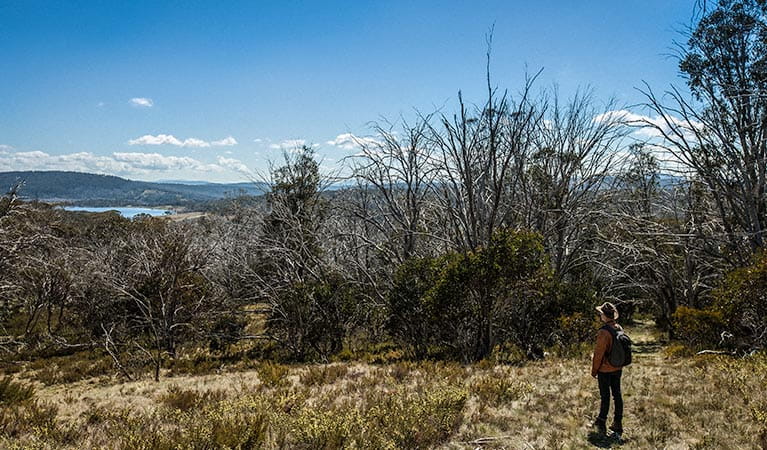Goldseekers track
Selwyn area in Kosciuszko National Park
Overview
This self-guided 3km loop track in Kosciuszko National Park is great for birdwatching, bushwalking, and nature photography during the warmer months and is a cross-country skiing or snowshoe track in winter.
- Where
- Selwyn area in Kosciuszko National Park in Snowy Mountains
- Accessibility
- Hard
- Distance
- 3km loop
- Time suggested
- 1 - 2hrs
- Grade
- Grade 3
- Trip Intention Form
-
It's a good idea to let someone know where you're going. Fill in a trip intention form to send important details about your trip to your emergency contact.
- Personal Locator Beacon
-
Hire a Personal Locator Beacon (PLB) for free at Snowy Region Visitor Centre in Jindabyne, Perisher Valley Office, Tumut Visitor Centre or Khancoban Visitor Centre.
- What to
bring - Drinking water, hat, sunscreen, topographic map, gps, compass
- Please note
There is limited mobile reception in this area of Kosciuszko National Park.
Follow this lovely self-guided loop track from Three Mile Dam campground as it meanders through snow gum woodlands, across snowgrass flats, and past an abandoned ore-crushing battery.
The scenery is nothing short of spectacular here at any time of year. In spring, it’s remarkable for its carpet of wildflowers, with beautiful displays of yellow billy buttons, white silver snow daisies, and pink grass trigger plants. In winter, it becomes a pristine alpine cross-country skiing or snowshoe track, exciting enough to satisfy any snow-lover.
Along the way, keep your eyes out for small mammals and birds that regularly visit here. The endangered eastern pygmy and ringtail possums make their homes in the hollows of old snow gums, as well as crimson rosellas and gang-gang cockatoos that feed on gumnuts and insect galls in the treetops.
Local alerts
For the latest updates on fires, closures and other alerts in this area, see https://www.nationalparks.nsw.gov.au/things-to-do/walking-tracks/goldseekers-track/local-alerts
General enquiries
- National Parks Contact Centre
- 7am to 7pm daily
- 1300 072 757 (13000 PARKS) for the cost of a local call within Australia excluding mobiles
- parks.info@environment.nsw.gov.au
Park info
- in the Selwyn area of Kosciuszko National Park in the Snowy Mountains region
The Selwyn area is open all year, but some roads and trails may close due to weather conditions or park management issues. Kings Cross Road and the Khancoban-Cabramurra Road are closed in winter (June to October long weekends). Some campgrounds in the Selwyn area close in winter.
-
Park entry fees apply in winter on Link Road
June to October long weekends: $29 per vehicle per day (24hrs from purchase); motorcycles $12; bus passengers $11.45 per adult, $3.60 per child per day (24hrs). Single and Multi-Day passes available from entry stations, NPWS visitor centres, pay machines or via the Park'nPay app.
See vehicle entry fees for other areas in Kosciuszko National Park.
Buy annual pass.
Visitor info
All the practical information you need to know about Goldseekers track.
Track grading
Features of this track
Distance
3km loop
Time
1 - 2hrs
Quality of markings
Clearly sign posted
Experience required
No experience required
Steps
No steps
Gradient
Short steep hills: There are short uphill and downhill sections along this track.
Quality of path
Formed track, some obstacles: The walk is 1.5m wide and has clumped grass along its length. There are points along the track where it narrows to 0.4m wide as it winds through trees.
In the northern part of the track, there are 2 steel pedestrian bridges – one is 1.8m wide and the other narrows the track slightly to 1.4m wide.
Getting there and parking
Get driving directions
Goldseekers track is in the central precinct of Kosciuszko National Park. To get there:
- Drive to Kiandra - 91km from Tumut and 38km from Adaminaby
- Turn onto the road to Cabramurra
- Drive for 5.7km to Three Mile Dam
Road quality
- It's recommended that all vehicles carry snow chains from the June to October long weekends. Read our snow driving in Kosciuszko tips.
Parking
Parking is available on Link Road, opposite the trackhead. It can be a busy place on the weekend, so parking may be limited.
Facilities
You'll need to bring your own drinking and cooking water
Toilets
There's a toilet opposite the trackhead on Link Road.
Maps and downloads
Accessibility
Disability access level - hard
Goldseekers track is 1.5m wide and step-free, but there are parts of the track that wheelchair users and people with reduced mobility may find difficult to navigate:
- The track has some short, steep uphill and downhill sections
- There are points where the track narrows to 0.4m wide as it winds through trees
- The track surface is mostly uneven, clumped grass
The parking on Link Road does not have any designated accessible parking spaces.
There's a toilet opposite the trackhead on Link Road, but it is not accessible or ambulant.
Prohibited
Drones
Flying a drone for recreational purposes is prohibited in this area. Drones may affect public enjoyment, safety and privacy, interfere with park operations, or pose a threat to wildlife. See the Drones in Parks policy.
This area may be a declared Drone Exclusion Zone, or may be subject to Civil Aviation Safety Authority (CASA) rules for flying near airports, aerodromes and helicopter landing sites. See CASA's Drone Flyer Rules.
Commercial filming and photography
Commercial filming or photography is prohibited without prior consent. You must apply for permission and contact the local office.
Learn more
Goldseekers track is in Selwyn area. Here are just some of the reasons why this park is special:
Kiandra's claims to fame
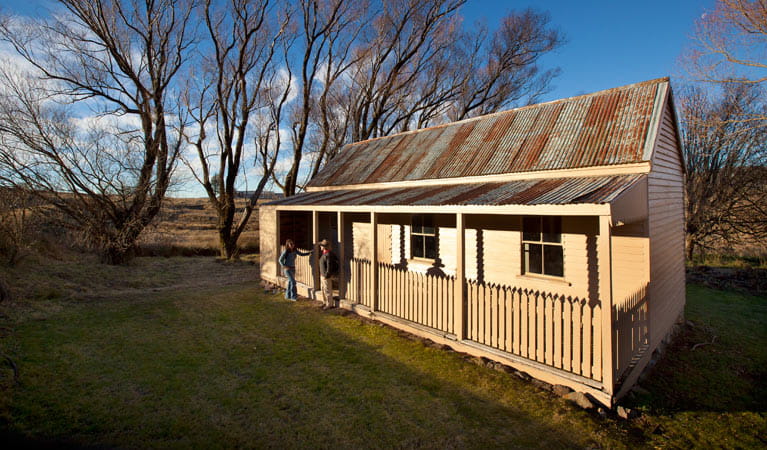
The discovery of gold at Kiandra in 1859 attracted up to 10,000 prospectors hoping to strike it rich. Just 18 months later, after harsh winters and falling gold finds, only a few hundred gold miners remained. It's remembered as one of Australia’s shortest gold rushes, not to mention it’s highest (and coldest). In 1861, Kiandra became the birthplace of skiing in Australia, when Norwegian gold miners fashioned skis from fence palings. By the 1870s regular ski carnivals were arranged, and Australia had its first official ski slope here. Mining continued into the 1930s, with grazing and winter skiing also keeping the community alive. Before devastating fires in 2019-2020, four buildings still stood here, including Kiandra Courthouse, which had served as a courthouse, private residence, ski chalet, hotel and bar.
Plants and animals protected in this park
Animals
-

Bare-nosed wombat (Vombatus ursinus)
A large, squat marsupial, the Australian bare-nosed wombat is a burrowing mammal found in coastal forests and mountain ranges across NSW and Victoria. The only other remaining species of wombat in NSW, the endangered southern hairy-nosed wombat, was considered extinct until relatively recently.
-
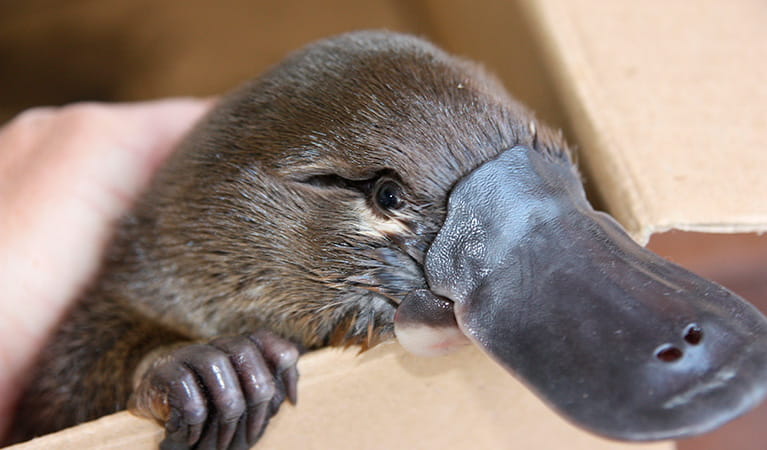
Platypus (Ornithorhynchus anatinus)
One of the most fascinating and unusual Australian animals, the duck-billed platypus, along with the echidna, are the only known monotremes, or egg-laying mammals, in existence. The platypus is generally found in permanent river systems and lakes in southern and eastern NSW and east and west of the Great Dividing Range.
-
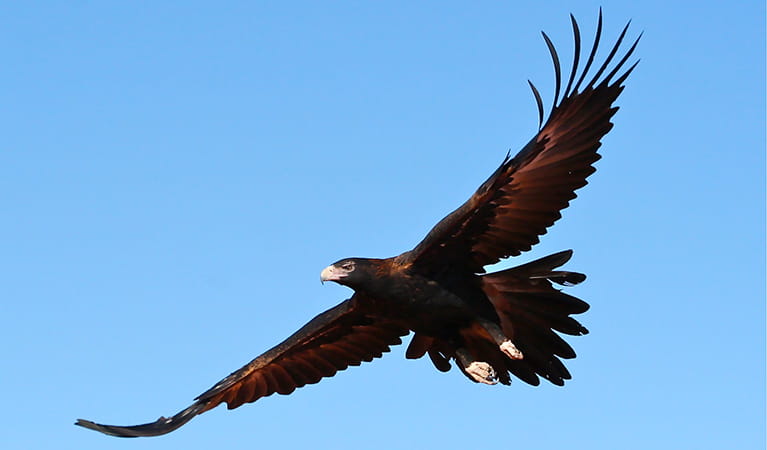
Wedge-tailed eagle (Aquila audax)
With a wingspan of up to 2.5m, the wedge-tailed eagle is Australia’s largest bird of prey. These Australian animals are found in woodlands across NSW, and have the ability to soar to heights of over 2km. If you’re bird watching, look out for the distinctive diamond-shaped tail of the eagle.
Plants
-
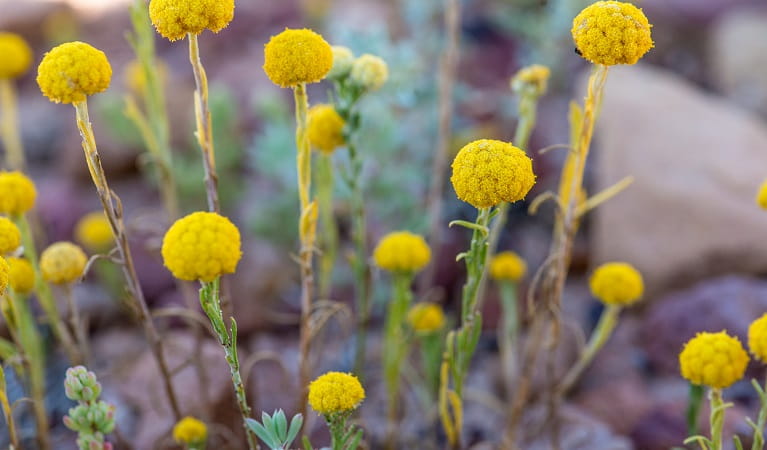
Billy buttons (Craspedia spp. )
Billy buttons are attractive Australian native plants that are widespread throughout eastern NSW in dry forest, grassland and alpine regions such as Kosciuszko National Park. The golden-yellow globe-shaped flowers are also known as woollyheads. Related to the daisy, billy buttons are an erect herb growing to a height of 50cm.

